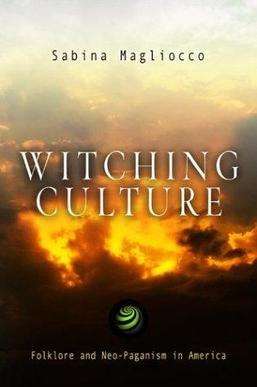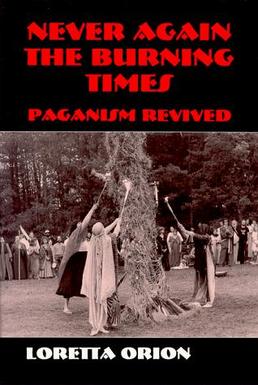
Dianic Wicca, also known as Dianic Witchcraft, is a modern pagan goddess tradition focused on female experience and empowerment. Leadership is by women, who may be ordained as priestesses, or in less formal groups that function as collectives. While some adherents identify as Wiccan, it differs from most traditions of Wicca in that only goddesses are honored.

Gardnerian Wicca, or Gardnerian witchcraft, is a tradition in the neopagan religion of Wicca, whose members can trace initiatory descent from Gerald Gardner. The tradition is itself named after Gardner (1884–1964), a British civil servant and amateur scholar of magic. The term "Gardnerian" was probably coined by the founder of Cochranian Witchcraft, Robert Cochrane in the 1950s or 60s, who himself left that tradition to found his own.

Wicca, also known as "The Craft", is a modern pagan, syncretic, earth-centered religion. Considered a new religious movement by scholars of religion, the path evolved from Western esotericism, developed in England during the first half of the 20th century, and was introduced to the public in 1954 by Gerald Gardner, a retired British civil servant. Wicca draws upon ancient pagan and 20th-century hermetic motifs for theological and ritual purposes. Doreen Valiente joined Gardner in the 1950s, further building Wicca's liturgical tradition of beliefs, principles, and practices, disseminated through published books as well as secret written and oral teachings passed along to initiates.
Alexandrian Wicca or Alexandrian Witchcraft is a tradition of the Neopagan religion of Wicca, founded by Alex Sanders who, with his wife Maxine Sanders, established the tradition in the United Kingdom in the 1960s. Alexandrian Wicca is similar in many ways to Gardnerian Wicca, and receives regular mention in books on Wicca as one of the religion's most widely recognised traditions.

Doreen Edith Dominy Valiente was an English Wiccan who was responsible for writing much of the early religious liturgy within the tradition of Gardnerian Wicca. An author and poet, she also published five books dealing with Wicca and related esoteric subjects.

Drawing Down the Moon: Witches, Druids, Goddess-Worshippers, and Other Pagans in America Today is a sociological study of contemporary Paganism in the United States written by the American Wiccan and journalist Margot Adler. First published in 1979 by Viking Press, it was later republished in a revised and expanded edition by Beacon Press in 1986, with third and fourth revised editions being brought out by Penguin Books in 1996 and then 2006 respectively.
Aidan A. Kelly is an American academic, poet and influential figure in the Neopagan religion of Wicca. Having developed his own branch of the faith, the New Reformed Orthodox Order of the Golden Dawn, during the 1960s, he was also initiated into other traditions, including Gardnerianism and Feri, in subsequent decades. Alongside this, he was also an important figure in the creation of the Covenant of the Goddess, an organisation designed to protect the civil rights of members of the Wiccan community in the United States. He has also published academic work studying the early development of Gardnerian Wiccan liturgy, primarily through his controversial 1991 book Crafting the Art of Magic.

Philip Heselton is a retired British conservation officer, a Wiccan initiate, and a writer on the subjects of Wicca, Paganism, and Earth mysteries. He is best known for two books, Wiccan Roots: Gerald Gardner and the Modern Witchcraft Revival and Gerald Gardner and the Cauldron of Inspiration, which gather historical evidence surrounding the New Forest coven and the origins of Gardnerian Wicca.
The history of Wicca documents the rise of the Neopagan religion of Wicca and related witchcraft-based Neopagan religions. Wicca originated in the early 20th century, when it developed amongst secretive covens in England who were basing their religious beliefs and practices upon what they read of the historical witch-cult in the works of such writers as Margaret Murray. It was subsequently founded in the 1950s by Gardner, who claimed to have been initiated into the Craft – as Wicca is often known – by the New Forest coven in 1939. Gardner's form of Wicca, the Gardnerian tradition, was spread by both him and his followers like the High Priestesses Doreen Valiente, Patricia Crowther and Eleanor Bone into other parts of the British Isles, and also into other, predominantly English-speaking, countries across the world. In the 1960s, new figures arose in Britain who popularized their own forms of the religion, including Robert Cochrane, Sybil Leek and Alex Sanders, and organizations began to be formed to propagate it, such as the Witchcraft Research Association. It was during this decade that the faith was transported to the United States, where it was further adapted into new traditions such as Feri, 1734 and Dianic Wicca in the ensuing decades, and where organizations such as the Covenant of the Goddess were formed.

Wiccan views of divinity are generally theistic, and revolve around a Goddess and a Horned God, thereby being generally dualistic. In traditional Wicca, as expressed in the writings of Gerald Gardner and Doreen Valiente, the emphasis is on the theme of divine gender polarity, and the God and Goddess are regarded as equal and opposite divine cosmic forces. In some newer forms of Wicca, such as feminist or Dianic Wicca, the Goddess is given primacy or even exclusivity. In some forms of traditional witchcraft that share a similar duotheistic theology, the Horned God is given precedence over the Goddess.

Vivianne Crowley is an English writer, university lecturer, psychologist, and a High Priestess and teacher of the Wiccan religion.

Neopagan witchcraft, sometimes referred to as The Craft, is an umbrella term for some neo-pagan traditions that include the practice of magic. These traditions began in the mid-20th century, and many were influenced by the witch-cult hypothesis; a now-rejected theory that persecuted witches in Europe had actually been followers of a surviving pagan religion. The largest and most influential of these movements was Wicca. Some other groups and movements describe themselves as "Traditional Witchcraft" to distinguish themselves from Wicca.
The Witchcraft Research Association was a British organisation formed in 1964 in an attempt to unite and study the various claims that had emerged of surviving remnants of the so-called Witch-Cult, such as those of Gerald Gardner, Robert Cochrane, Sybil Leek, Charles Cardell, and Raymond Howard.
In Modern English, the term Wicca refers to Wicca, the religion of contemporary Pagan witchcraft. It is used within the Pagan community under competing definitions. One refers to the entirety of the Pagan Witchcraft movement, while the other refers explicitly to traditions included in what is now called British Traditional Wicca.

A Community of Witches: Contemporary Neo-Paganism and Witchcraft in the United States is a sociological study of the Wiccan and wider Pagan community in the Northeastern United States. It was written by American sociologist Helen A. Berger of the West Chester University of Pennsylvania and first published in 1999 by the University of South Carolina Press. It was released as a part of a series of academic books entitled Studies in Comparative Religion, edited by Frederick M. Denny, a religious studies scholar at the University of Chicago.

Witching Culture: Folklore and Neo-Paganism in America is a folkloric and anthropological study of the Wiccan and wider Pagan community in the United States. It was written by the American anthropologist and folklorist Sabina Magliocco of California State University, Northridge and first published in 2004 by the University of Pennsylvania Press. It was released as a part of a series of academic books titled 'Contemporary Ethnography', edited by the anthropologists Kirin Narayan of the University of Wisconsin and Paul Stoller of West Chester University.

Enchanted Feminism: The Reclaiming Witches of San Francisco is an anthropological study of the Reclaiming Wiccan community of San Francisco. It was written by the Scandinavian theologian Jone Salomonsen of the California State University, Northridge and first published in 2002 by the Routledge.

Never Again the Burning Times: Paganism Revisited is an anthropological study of the Wiccan and wider Pagan community in the United States. It was written by the American anthropologist Loretta Orion and published by Waveland Press in 1995.

Witchcraft and Paganism in Australia is an anthropological study of the Wiccan and wider Pagan community in Australia. It was written by the Australian anthropologist Lynne Hume and first published in 1997 by Melbourne University Press.

Magic, Witchcraft and the Otherworld: An Anthropology is an anthropological study of contemporary Pagan and ceremonial magic groups that practiced magic in London, England, during the 1990s. It was written by English anthropologist Susan Greenwood based upon her doctoral research undertaken at Goldsmiths' College, a part of the University of London, and first published in 2000 by Berg Publishers.















